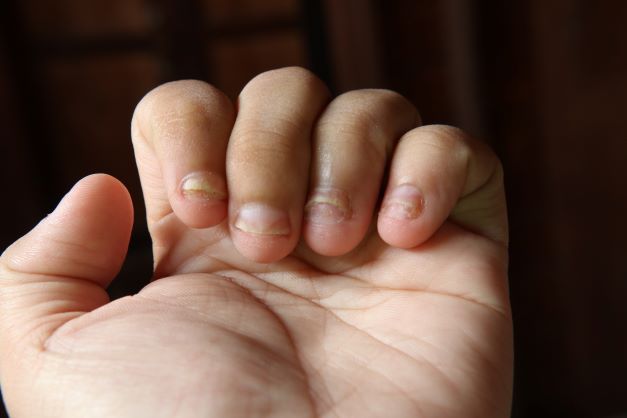While most people are familiar with psoriasis and the effect it has on the skin, many are surprised to hear that psoriasis can impact the nails as well. According to Dr. Sam Awan of U.S. Dermatology Partners in McKinney, Texas, “Nail psoriasis isn’t the most common form of psoriasis. However, those who have it should seek treatment as soon as possible since nail psoriasis can be difficult to treat compared to other forms of psoriasis. For this reason, it’s important to get started working with a dermatologist to begin the treatment process as soon as possible.” In this blog, Dr. Awan will review the warning signs of nail psoriasis, available treatment options, and prevention methods to manage flare-ups.
So, Exactly What Is Nail Psoriasis?
Psoriasis is the name given to a group of common skin and systemic health conditions. The most common forms of psoriasis occur when the immune system overreacts after exposure to multifactorial stimuli; this hyperactivated immune system can lead to thick patches of skin called plaques and arthritic joint inflammation.
Nail psoriasis occurs when the immune system activity leads to changes in the texture and appearance of nails by causing damage to the nails and nail beds. While psoriasis can impact the fingernails and toenails, it is much more commonly found on the fingernails. Although nail psoriasis usually occurs in patients who already have skin psoriasis, it can uncommonly be the first presenting sign of nail psoriasis. Studies have also shown that patients who have nail psoriasis have a higher risk of developing arthritis linked to their psoriasis, and so these patients may have to be managed by both a dermatologist and a rheumatologist.
How Can Someone Tell that They Have It?
According to Dr. Awan, “The appearance of nail psoriasis will vary from person to person. However, it should be pretty obvious that there is something out of the ordinary. If you notice significant changes in the health or appearance of your nails, you should consult with a dermatologist. They can help confirm a nail psoriasis diagnosis as well as partner with you to create a treatment plan.”
While symptoms of nail psoriasis may vary, some of the most common include:
- Changes in the nail’s appearance like changing shape or becoming uneven or rough
- Nails becoming thicker
- Pitting or breaking
- Nails separating from the nail bed
- Discoloration
- Blood spots beneath the nails
What Treatments Are Available?
Treatment will depend in large part on the severity and frequency of nail psoriasis flare-ups. In most cases, dermatologists will utilize the same types of treatments for nail psoriasis that they would utilize for psoriasis flare-ups on other parts of the body. Whatever treatment plan your dermatologist puts in place, Dr. Awan cautions, “Give treatment time to work. It can be frustrating, but there truly is no overnight solution to treat nail psoriasis. Any treatment will take time to be effective. In fact, nail psoriasis treatment may take up to a year to deliver the desired results, but patients need to stick with it and follow their dermatologist’s directions closely to see improvement.”
Some of the most common treatments utilized for nail psoriasis include:
- Topical medicine – Applied in creams, ointments, or even nail polishes, topical medications offer numerous benefits and address many of the common symptoms of nail psoriasis. These products are available in both over-the-counter and prescription-strength formulations. Topical nail psoriasis treatment products are designed to be applied directly to the affected nails a few times each day, and they may include ingredients like corticosteroids, vitamin D, and anti-inflammatory medicines.
- Injectable medications – Specifically, corticosteroid medications may be utilized as part of a comprehensive nail psoriasis treatment plan, especially for those who have symptoms like nail separation and thickening.
- Oral medications – In most cases, topical treatments and corticosteroid injections are the first course of treatment recommended for nail psoriasis. For flare-ups that impact several nails, symptoms that are more severe, or flare-ups that aren’t responsive to other treatments, oral medications may be prescribed. Oral medications can be especially beneficial for individuals who have psoriasis on more of their body and those who suffer from psoriatic arthritis in addition to nail psoriasis. Some common medications that may be prescribed include antifungals, retinoids, apremilast, cyclosporine, and methotrexate.
- Biologics – Like other types of psoriasis, nail psoriasis may be responsive to treatment using biologics. Biologics work to correct the hyperactive immune system that is the root cause of psoriasis and are the most effective overall treatment for psoriasis available today.
- Dermatologic procedures – Treatments like laser and phototherapy can offer some relief during nail psoriasis flare-ups.
Can Flare-ups Be Prevented?
In most cases, flare-ups can’t be prevented entirely. However, there are many steps patients can take to significantly minimize the risk for flare-ups and diminish the severity of flare-ups that do occur, including:
- Treat nails gently. Don’t chew or pick at nails, use nails as tools, or otherwise expose nails, nailbeds, and cuticles to damage. This can trigger something called the Koebner phenomenon that can cause nail psoriasis flare-ups.
- For the same reason, people who struggle with nail psoriasis should wear gloves when performing tasks that may cause unintentional damage to nails, including things like gardening, lifting heavy or rough items, or even doing the dishes.
- Keep nails trimmed, clean, and moisturized. This diminishes the risk for nails to be bent, lifted from the nailbed, or for dryness or micro-injuries to cause infection that can take hold within injured skin around the nails.
- Cease or significantly diminish tobacco usage, which has been shown to increase the risk for nail psoriasis flare-ups.
- Learn your individual triggers. Anytime you notice nail psoriasis flare-ups, try to gauge the potential factors that have contributed to the flare-up, so you can minimize or remove exposure to these triggers.
When Should I See a Dermatologist?
Nail psoriasis will not typically clear up on its own, and without proper treatment, it’s likely to become more severe and difficult to manage. If you notice warning signs that you believe are related to nail psoriasis, get in touch with a U.S. Dermatology Partners location near your home or office to schedule a consultation. When you’re ready to get started, complete our online scheduling request form. A local team member will be in touch to finalize the details of your visit.
Find a location near me
or


